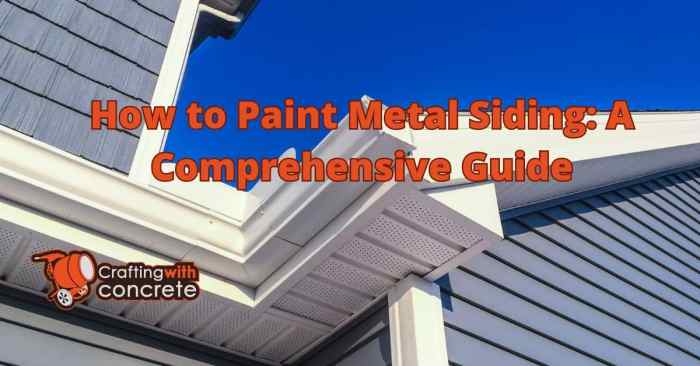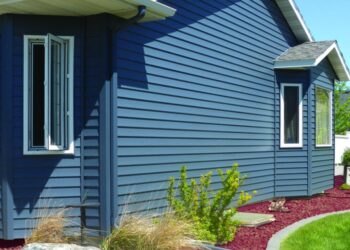Embarking on the journey of painting metal siding on a house involves a series of crucial steps and decisions. From preparation to maintenance, every aspect plays a vital role in ensuring a successful outcome. Let's delve into the intricacies of this process to uncover the secrets of achieving a flawless finish that enhances the beauty of your home.
As we explore the world of painting metal siding, we will unravel the mysteries behind choosing the right paint, mastering painting techniques, and preserving the longevity of your newly painted surface. Get ready to transform your house with a fresh coat of paint that will stand the test of time.
Preparation for Painting

To ensure a successful paint job on metal siding, proper preparation is crucial. This involves cleaning the surface, applying primer, and gathering the necessary tools and materials.
Cleaning the Surface
Before painting, it is essential to clean the metal siding thoroughly to remove any dirt, dust, or debris that could affect the adhesion of the paint. Use a pressure washer or a hose with a scrub brush to scrub the surface clean.
For stubborn stains, consider using a mild detergent or a specialized cleaner.
Priming the Surface
After cleaning, it is important to prime the metal siding to create a smooth and uniform surface for the paint to adhere to. Primer helps the paint bond better and provides added protection against rust and corrosion. Choose a high-quality metal primer suitable for exterior use.
Tools and Materials
- Pressure washer or hose
- Scrub brush
- Mild detergent or specialized cleaner
- Metal primer
- Paintbrushes or paint sprayer
- High-quality exterior paint suitable for metal surfaces
By following these preparation steps and using the right tools and materials, you can ensure a professional and long-lasting finish when painting metal siding on your house.
Choosing the Right Paint
When it comes to painting metal siding on a house, selecting the right paint is crucial for achieving a long-lasting and visually appealing finish. Different types of paint offer various benefits, and choosing the one that suits your needs is essential.:There are several types of paint suitable for metal siding, including acrylic, latex, oil-based, and enamel paints.
Acrylic and latex paints are popular choices for their ease of application, quick drying time, and resistance to fading. Oil-based paints provide a durable finish and are ideal for high-traffic areas. Enamel paints offer excellent adhesion and protection against rust and corrosion.
Selecting Paint Colors
When choosing paint colors for your house's exterior, consider the existing color scheme, architectural style, and surrounding landscape. Opt for colors that complement the overall aesthetics of your home while adding curb appeal. Neutral tones like gray, beige, and taupe are versatile options that work well with various architectural styles.
Bold colors can make a statement and add personality to your home, but be mindful of how they blend with the surroundings.
Advantages of Specific Paint Types
- Acrylic and Latex Paints: These paints are easy to clean, resist mildew and fading, and provide excellent coverage.
- Oil-Based Paints: Ideal for high-traffic areas, oil-based paints offer superior adhesion and durability, making them suitable for metal siding.
- Enamel Paints: With their high-gloss finish, enamel paints provide exceptional protection against rust and corrosion, ensuring the longevity of your metal siding.
Painting Techniques
When painting metal siding on a house, it is essential to use the right techniques to ensure a smooth and even finish that will last for years to come. Here are some tips and techniques to help you achieve the best results:
Proper Surface Preparation
Before you start painting, make sure the metal siding is clean and free from any dirt, rust, or old paint. Use a pressure washer or a scrub brush with a mixture of water and detergent to clean the surface thoroughly.
Allow it to dry completely before proceeding with the painting process.
Use of Brushes, Rollers, or Sprayers
When it comes to painting metal siding, you have the option to use brushes, rollers, or sprayers. Each method has its own advantages and considerations:
- Brushes: Brushes are great for detailed work and reaching tight corners. Use a high-quality brush with synthetic bristles for smooth application.
- Rollers: Rollers are ideal for covering large areas quickly. Use a roller with a 3/8-inch nap for metal surfaces to ensure even coverage.
- Sprayers: Sprayers can provide a smooth and uniform finish, but they require more preparation and cleanup. Make sure to choose a sprayer suitable for painting metal surfaces.
Techniques for Achieving a Smooth Finish
To achieve a smooth and even finish when painting metal siding, follow these techniques:
- Apply thin coats: Instead of applying a thick layer of paint, it is better to apply multiple thin coats. This will help prevent drips and ensure better adhesion to the metal surface.
- Work in small sections: Divide the siding into manageable sections and work on one section at a time. This will help you maintain a wet edge and avoid lap marks.
- Follow the grain: If your metal siding has a grain or texture, make sure to paint in the direction of the grain for a more professional finish.
- Allow proper drying time: Make sure to follow the manufacturer's instructions regarding drying times between coats. This will help prevent the paint from cracking or peeling.
Maintenance and Longevity
Metal siding can be a durable and long-lasting option for your home's exterior, especially when properly maintained. To ensure the longevity of your painted metal siding, it is important to follow a few key maintenance steps and know when it's time to consider repainting.
Regular Cleaning and Inspections
Regularly cleaning your painted metal siding with a mixture of mild soap and water can help prevent dirt and grime buildup, maintaining its appearance and protecting the paint. Additionally, inspecting the siding for any signs of damage, such as rust or chipping paint, can help you address issues promptly before they worsen.
Repainting Considerations
When you start noticing significant fading, peeling, or chipping of the paint on your metal siding, it may be time to consider repainting. Repainting not only enhances the curb appeal of your home but also provides added protection against the elements, extending the lifespan of the siding.
Weatherproofing Tips
- Choose a high-quality exterior metal paint specifically designed for durability and weather resistance.
- Apply a primer before painting to ensure better adhesion and protection against rust.
- Consider adding a clear coat or sealant over the paint to provide an extra layer of protection against UV rays and harsh weather conditions.
- Regularly inspect the painted metal siding for any signs of wear and tear, especially after severe weather events, and touch up any damaged areas promptly.
Closing Notes
In conclusion, painting metal siding on a house is not just a task but a form of art that requires attention to detail and a touch of creativity. By following the guidelines Artikeld in this comprehensive guide, you can elevate the appearance of your home and protect it from the elements for years to come.
Take the first step towards a vibrant and resilient exterior by embracing the world of metal siding painting today.
Essential FAQs
How often should I repaint my metal siding?
It is recommended to repaint metal siding every 5-10 years to maintain its appearance and protection.
Can I use a roller to paint metal siding?
Yes, a roller can be used for painting metal siding, especially for larger flat surfaces to achieve a smooth finish.
Do I need to prime metal siding before painting?
Yes, priming metal siding is crucial as it helps the paint adhere better and enhances durability.
What type of paint is best for metal siding?
Acrylic latex paint is commonly recommended for metal siding due to its durability and weather resistance.
How can I weatherproof my painted metal siding?
Applying a clear sealant or topcoat over the painted surface can help enhance weatherproofing and longevity.














